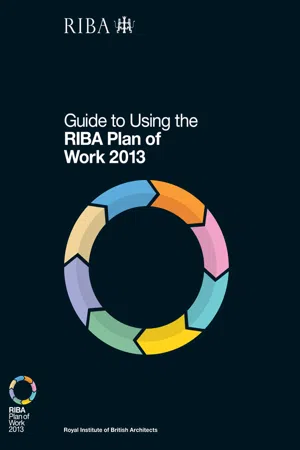
- 96 pages
- English
- ePUB (mobile friendly)
- Available on iOS & Android
Guide to Using the RIBA Plan of Work 2013
About This Book
The RIBA Plan of Work 2013 is the definitive framework for the contemporary building design and construction process. It provides a stage-by-stage model to assist all members of the project team to manage the process from inception to completion and beyond. This practical guide explains how the RIBA Plan of Work 2013 can be applied for optimal results in construction projects, revealing the Plan of Work as much more than just a project framework. It can be used as a tool to ensure best outcomes and guide thinking across a range of key themes including whole life costs, procurement routes, BIM, and social and environmental sustainability.
With useful explanations of the various stages and technical terms, this book is packed with guidance and tips for using the Plan of Work to ensure genuinely integrated projects. Intended as complementary to the RIBA Plan of Work 2013 Online, the RIBA Job Book, and Assembling the Project Team, it is for construction professionals industry-wide, from architectural practices to clients and contractors, as well as students studying for their professional examinations.
Frequently asked questions
Information
Chapter 1
Introduction

- • explains the importance of the project team and details the suite of documents required to assemble a successful project team
- • underlines and considers the importance of whole life costs
- • highlights the importance of Project Outcomes and why they are an essential briefing consideration
- • clarifies how the RIBA Plan of Work 2013 enables the most progressive of Building Information Modelling (BIM) projects
- • considers how the RIBA Plan of Work 2013 engenders best practice in health and safety, and
- • demonstrates how the RIBA Plan of Work 2013 assists the implementation of sustainability measures.

What is the RIBA Plan of Work?

Why is a major update of the RIBA Plan of Work necessary?
- 1. Previous editions of the RIBA Plan of Work related to one form of procurement: traditional. The RIBA Plan of Work 2013 consultation process confirmed the fact that many different forms of procurement are used. It is now essential that the Plan of Work is relevant to any of the procurement routes currently in use.
- 2. Time constraints inevitably place greater pressure on front-end design work. There is a need to recalibrate the initial stages to ensure that the brief is properly developed and the project team is properly assembled.
- 3. The RIBA Outline Plan of Work 2007 acknowledged the potential increase in the scope of post-occupancy duties. The nature of post-occupancy duties has certainly become more onerous, but a crucial factor is the need to identify these duties at the outset of a project.
- 4. There has been a shift in emphasis from the design team to the project team (consisting of client + design team + contractor) and the lead designer role is frequently underplayed and misunderstood. The new RIBA Plan of Work must address the concept of the project team and redefine and reinforce the lead designer and project lead roles.
- 5. The RIBA Outline Plan of Work 2007 does not recognise the design work undertaken by specialist contractors. For some time now JCT contracts have acknowledged this subject by including a clause requiring such work to be stated in the Building Contract. The RIBA Plan of Work needs to embrace this common way of working.
- 6. The Information Age is fundamentally changing the way that we design, communicate, store and harness information. The RIBA Plan of Work has to address the implications of what some people call the ‘Third Industrial Revolution’. While BIM is used as a catchall phrase for this important subject, the RIBA Plan of Work must consider the broader context.
- 7. Many practitioners utilise terms such as C+ or D− to refer to the point when a planning application is made. The RIBA Plan of Work must reflect these cultural ‘norms’ as well as acknowledging the need for pre-application activities or the increased importance of addressing any conditions attached to a planning consent.
- 8. The information produced at Stages D, E and F1 varies widely depending on the client, practice or project. The RIBA Plan of Work 2013 aims to provide greater clarity on this subject.
What are the main changes to the RIBA Plan of Work?
- • The RIBA Plan of Work 2013 has eight stages and eight ‘task bars’. The task bars define groups of related tasks that run across all the stages. This is a shift from the 11 stages and two task bars (headed ‘Description of key tasks’ and ‘OGC Gateways’) contained in the RIBA Outline Plan of Work 2007. The new stages and task bars are set out in detail in Chapter 2.
- • The RIBA Plan of Work 2013 has been developed as a template that allows a bespoke practice- or project-specific Plan of Work to be created via www.ribaplanofwork.com. Selecting the correct task bar from the three variable task bars for Procurement, Programme and (Town) Planning, and thus defining your own practice- or project-specific Plan, is a crucial part of the RIBA Plan of Work 2013.
- • The eight ...
Table of contents
- Cover
- Title
- Copyright
- Foreword
- Contents
- 1 Introduction
- 2 The RIBA Plan of Work 2013
- 3 Establishing your project team
- 4 Defining whole life costs
- 5 Project Outcomes
- 6 Harnessing Building Information Modelling (BIM) using the Plan
- 7 The changing nature of project handover
- 8 Sustainability
- 9 Enhancing health and safety
- 10 Terms used throughout the RIBA Plan of Work
- Index